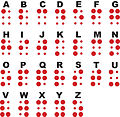Category:Braille letters (6 dots)
| 1 | 4 |
| 2 | 5 |
| 3 | 6 |
In this category, the images of 6-dots Braille patterns are numbering dots 1 to 6 vertically (as shown in the table on the right). These characters are assigned in the Unicode and ISO/IEC 10646 standards at the begining of the "Braille Patterns" block (in the subrange U+2800..U+283F) and ordered so that the lowest 6 bits of their code point values are numbered in the same order as this traditional numbering of dots in standard Braille patterns.
However their names given in the images below indicate the letters (without distinction of case), digits, or symbols mapped on those patterns in the French Braille standard. There are differences across languages (and scripts) about how their letters (or sometimes digrams or trigrams) are assigned to each symbol. However there's a consensus for the basic alphabet of each script, so basic Latin letters are normally assigned to the same Braille patterns in all languages using the same Latin letters (those standard mappings are shown with yellow background in the table below); some basic Latin letters not used within a given language may be replaced by other letters, digrams or symbols. Many Braille patterns may play also different roles contextually, by mean of a few special prefix patterns (to allow distinctions of capitals vs. minuscules; or letters vs. digits, maths symbols, and abreviations).
| .0 | .1 | .2 | .3 | .4 | .5 | .6 | .7 | .8 | .9 | .A | .B | .C | .D | .E | .F | |
|---|---|---|---|---|---|---|---|---|---|---|---|---|---|---|---|---|
| U+280. |
※ |
A 1 |
, |
B 2 |
’ |
K |
; |
Braille L |
※ |
C 3 |
I 9 |
F 6 |
Ì |
M |
S |
P |
| U+281. |
※ |
E 5 |
: |
H 8 |
* |
O |
! |
R |
※ |
D 4 |
J 0 |
G 7 |
Ä |
N |
T |
Q |
| U+282. |
※ |
Å |
? |
Ê |
- |
svg |
※ |
V |
※ |
Î |
Ö |
Ë |
Ò |
X |
È |
Ç |
| U+283. |
※ |
Û |
. |
Ü |
※ |
|
() |
À |
※ |
Ô |
W |
Ï |
※ |
Y |
Ù |
É |
- ※ marks positions for special characters
The traditional order of Braille patterns is different, and consists in several groups of growing reading complexity, but arranged for easier learning (an additional subset only contains the fixed-width empty pattern, used like a space for word separation). Patterns shown with red background are used as prefixes or notations with special purpose. For example :
- Letters by default are all lowercase, except when prefixed by a capitalize special pattern (if this special pattern occurs twice, the following letters are explicitly emphasized to all uppercase, up to the end of word; special sequences starting by other special patterns may be used for longer runs of capitalized text). Basic letters (with yellow background) are standard across languages, other languages may assign them differently (the assignments below are standardized for French, those above are for German). Two successive capitalize special patterns can prefix the small-capitals case of letters (typically used for noting Roman numbers).
- Digits encoded in the 10 positions of group 1 are only valid after the special number prefix pattern, up to a space pattern or a base-value pattern that restores the alphabetic mode; however they are replaced by the 9 first patterns of group 4 or by the number pattern for digit 0, when using instead the maths prefix pattern (which also encodes more characters in groups 5 and 6, while keeping all basic Latin letters in groups 1 to 4 for the abbreviated notation of alphanumeric values), or after the superscript and subscript special patterns, up to the next punctuation or the next base-value special pattern or the next space or line-break.
- Punctuation signs in group 5 are normally always followed by a space; this also allows additional typographic symbols (including some that are specific to the Braille script) to be composed by using two or three patterns assigned to punctuation signs, and/or to extended letters (outside the basic set shown with yellow background). Opening and closing quotation marks are glued without any space to the words they enclose, so they are encoded identically (exceptions to this interpretation rule may use the base-value special pattern).
- The two special modifier prefixes can be used to replace standard characters mnemonically (e.g. currency signs, letter-like symbols, or related punctuation).
- Finally, the symbol with all 6 dots set (in group 3) will be interpreted as an erasure when it is repeated (this is used to cancel a composition error when Braille patterns are punched directly on paper, or to signal a missing value in a table cell).
|
|
| |||||||||||||||||||||||||||||||||||||||||||||||||||||||||||||||||||||||||||||||||||||
 | This category contains SVG files showing very simple images. Drawing uncomplicated graphics with a text editor seems more adequate than using a vector graphics program, and will often result in a dramatic reduction of file size. For an example, see the file Braille X.svg. |
Subcategories
This category has the following 8 subcategories, out of 8 total.
1
- 1829 Braille (127 F)
B
- Braille symbols (1 F)
C
- Color-coded braille (137 F)
E
- Esperanto Braille (2 F)
H
- Hebrew Braille (27 F)
J
K
- Korean braille (29 F)
T
- Tamil Braille (33 F)
Media in category "Braille letters (6 dots)"
The following 118 files are in this category, out of 118 total.
-
Braille NULL.svg 154 × 215; 312 bytes
-
Braille A1.svg 154 × 215; 431 bytes
-
Braille Comma.svg 154 × 215; 431 bytes
-
Braille B2.svg 154 × 215; 417 bytes
-
Braille Apostrophe.svg 154 × 215; 431 bytes
-
Braille K.svg 154 × 215; 417 bytes
-
Braille L.svg 154 × 215; 403 bytes
-
Braille Accent.svg 154 × 215; 431 bytes
-
Braille C3.svg 154 × 215; 417 bytes
-
Braille I9.svg 154 × 215; 417 bytes
-
Braille F6.svg 154 × 215; 403 bytes
-
Braille ST.svg 154 × 215; 337 bytes
-
Braille M.svg 154 × 215; 403 bytes
-
Braille S.svg 154 × 215; 403 bytes
-
Braille P.svg 154 × 215; 389 bytes
-
Braille ContractionPrefix.svg 154 × 215; 431 bytes
-
Braille E5.svg 154 × 215; 417 bytes
-
Braille Colon.svg 154 × 215; 417 bytes
-
Braille H8.svg 154 × 215; 403 bytes
-
Braille Asterisk.svg 154 × 215; 417 bytes
-
Braille O.svg 154 × 215; 403 bytes
-
Braille ExclamationPoint.svg 154 × 215; 403 bytes
-
Braille R.svg 154 × 215; 389 bytes
-
Braille Currency.svg 154 × 215; 358 bytes
-
Braille Semicolon.svg 154 × 215; 417 bytes
-
Braille D4.svg 154 × 215; 403 bytes
-
Braille J0.svg 154 × 215; 403 bytes
-
Braille G7.svg 154 × 215; 389 bytes
-
Braille Ä.svg 154 × 215; 403 bytes
-
Braille N.svg 154 × 215; 389 bytes
-
Braille T.svg 154 × 215; 389 bytes
-
Braille Q.svg 154 × 215; 375 bytes
-
Braille CapitalSign.svg 154 × 215; 431 bytes
-
Braille Å.svg 154 × 215; 313 bytes
-
Braille QuestionMark.svg 154 × 215; 417 bytes
-
Braille Ê.svg 154 × 215; 403 bytes
-
Braille Hyphen.svg 154 × 215; 417 bytes
-
Braille U.svg 154 × 215; 403 bytes
-
Braille QuoteOpen.svg 154 × 215; 403 bytes
-
Braille V.svg 154 × 215; 389 bytes
-
Braille DecimalPoint.svg 154 × 215; 417 bytes
-
Braille SH.svg 154 × 215; 403 bytes
-
Braille Ö.svg 154 × 215; 358 bytes
-
Braille Ë.svg 154 × 215; 389 bytes
-
Braille Ò.svg 154 × 215; 403 bytes
-
Braille X.svg 154 × 215; 312 bytes
-
Braille È.svg 154 × 215; 351 bytes
-
Braille AND.svg 154 × 215; 375 bytes
-
Braille Correction.svg 154 × 215; 417 bytes
-
Braille Û.svg 154 × 215; 403 bytes
-
Braille Period.svg 154 × 215; 403 bytes
-
Braille Ü.svg 154 × 215; 389 bytes
-
Braille QuoteClose.svg 154 × 215; 403 bytes
-
Braille Z.svg 154 × 215; 389 bytes
-
Braille Bracket.svg 154 × 215; 389 bytes
-
Braille À.svg 154 × 215; 375 bytes
-
Braille CursiveSign.svg 154 × 215; 403 bytes
-
Braille Ô.svg 154 × 215; 389 bytes
-
Braille W.svg 154 × 215; 389 bytes
-
Braille Ï.svg 154 × 215; 375 bytes
-
Braille NumberSign.svg 154 × 215; 389 bytes
-
Braille Y.svg 154 × 215; 375 bytes
-
Braille Ù.svg 154 × 215; 331 bytes
-
Braille É.svg 154 × 215; 361 bytes
-
Braille 101101sq.svg 154 × 215; 335 bytes
-
Agenda en braille.jpg 3,680 × 2,760; 5.95 MB
-
Augsburg 2013-03-13-2227.jpg 4,752 × 3,168; 5.68 MB
-
Augsburg 2013-03-13-2228.jpg 4,752 × 3,168; 6.3 MB
-
Augsburg 2013-03-13-2230.jpg 3,168 × 4,752; 4.89 MB
-
Bahnhofsplan für Blinde, Hannover Hbf, Ausschnitt Eingangsbereich.jpg 2,816 × 2,112; 2.59 MB
-
Bahnhofsplan für Blinde, Hannover Hbf, Ausschnitt Windrose.jpg 2,816 × 2,112; 2.97 MB
-
Blindenschrift Handlauf Hauptbahnhof Dresden - (Zu den Gleisen 3-4) - Bild 001.jpg 4,724 × 8,399; 9.49 MB
-
Blindenschrift Handlauf Hauptbahnhof Dresden - (Zu den Gleisen 3-4) - Bild 002.jpg 4,724 × 8,399; 9.95 MB
-
Braile07.jpg 194 × 187; 8 KB
-
Braill cell.gif 220 × 328; 6 KB
-
Braille (physical) xy-axis.png 391 × 400; 30 KB
-
Braille 6.svg 215 × 130; 1 KB
-
Braille alfabet.jpg 493 × 363; 19 KB
-
Braille alphabet.jpg 450 × 437; 51 KB
-
Braille calendar cs.jpg 700 × 525; 60 KB
-
Braille cell.svg 155 × 216; 3 KB
-
Braille code dimensions.jpg 384 × 512; 38 KB
-
Braille md'a.JPG 3,648 × 2,736; 1.49 MB
-
Braille music.jpg 678 × 254; 15 KB
-
Braille symbol (fixed width).svg 15 × 15; 4 KB
-
Braille zh.jpg 76 × 106; 4 KB
-
Braille-Makeyev tactile writing system.jpg 2,172 × 1,176; 486 KB
-
Braille.png 47 × 43; 423 bytes
-
Braille2.jpg 5,472 × 3,648; 4.28 MB
-
Braillemusicsummary.gif 585 × 763; 12 KB
-
Brailleschrift 04 KMJ.svg 470 × 450; 712 bytes
-
Brailleschrift 05 KMJ.png 768 × 987; 104 KB
-
Brailleschrift 05 KMJ.svg 562 × 725; 24 KB
-
Brailleschrift 06 KMJ.png 768 × 1,244; 60 KB
-
Brailleschrift 06 KMJ.svg 768 × 1,244; 7 KB
-
Braille Ç.svg 154 × 215; 375 bytes
-
Braille Ì.svg 154 × 215; 337 bytes
-
Braille Î.svg 154 × 215; 403 bytes
-
Brajlo.svg 220 × 329; 12 KB
-
CH Braille.PNG 77 × 115; 1 KB
-
Chambers 1908 Braille.png 25 × 28; 191 bytes
-
Church of the Pater Noster it fr.jpg 2,592 × 1,944; 1.09 MB
-
Comparative Lettering Hauy-Barbier-Braille.tif 300 × 300; 288 KB
-
Haltepunkt Gennweiler (2022-07-15) 10.jpg 5,504 × 8,256; 20.89 MB
-
Helen Keller Braille.svg 340 × 160; 2 KB
-
HelenKeller.png 592 × 292; 6 KB
-
Jerusalem Braille Pater Noster - Carmelite sisters - Mount of Olives (6035886321).jpg 2,816 × 2,112; 2.59 MB
-
Perkins logo.jpg 2,363 × 1,109; 957 KB
-
Perkins School for the Blind logo.png 795 × 212; 29 KB
-
Perkins.jpg 2,363 × 1,109; 952 KB
-
Primeira-serie-braille.JPG 937 × 172; 22 KB
-
Segunda-serie-braille.JPG 928 × 168; 23 KB
-
Signo-xerador-escribir.JPG 154 × 215; 5 KB
-
Synagoge & Elementarschule Ottweiler (Modell) 2018-11-11 (02).jpg 7,138 × 4,338; 14.52 MB
-
Terceira-serie-braille.JPG 937 × 172; 13 KB
-
Übersicht Blindenschrift.jpg 640 × 924; 104 KB












































































































